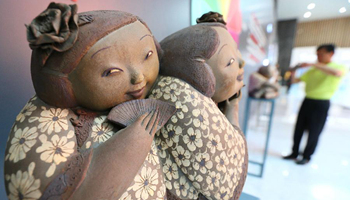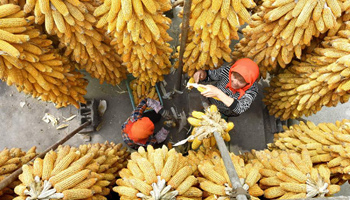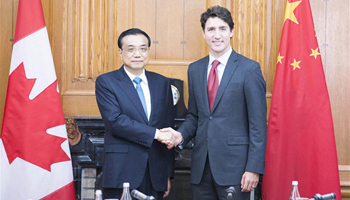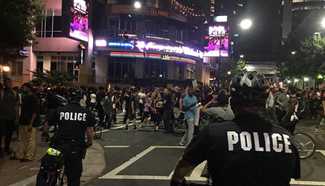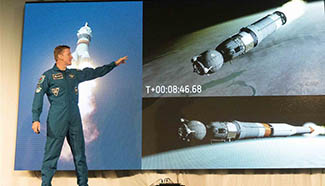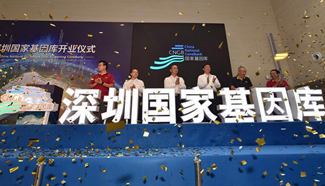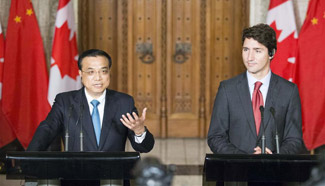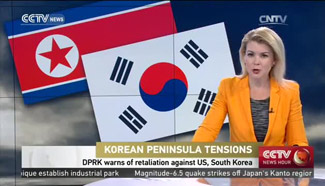BEIJING, Sept. 23 (Xinhua) -- It is almost closing time at the China Science and Technology Museum (CSTM) and six-year-old Shi Jiajun is still standing in line, somewhat forlornly, in front of a "spacecraft," waiting for a "ride."
Jiajun is from Urumqi in China's far northwest. He and his mother have just arrived in Beijing for a brief visit. They have a tight schedule, but for Jiajun, this is an important stop.
Since Sept. 17, the CSTM has been hosting an aerospace exhibition as part of China's annual Science Day activities. With 2016 being the 60th year of China's aerospace endeavors, this exhibition is extra special.
The "spacecraft" is very popular with visitors. Mostly white, and composed of two bullet-like parts, it is nothing much to look at, despite the Chinese word -- "Shenzhou" -- emblazoned on one side of its body.
Shenzhou is the name of a series of manned spacecraft. The word holds the same place in the hearts of the Chinese people as "Apollo" does among Americans of a certain age. After China launched its first manned spacecraft "Shenzhou-5" with an astronaut on board in 2003, new generations have carried nine astronauts into space.
Later this year, "Shenzhou-11" manned spacecraft will carry astronauts into space to dock with "Tiangong-2", the space lab sent last week. As the first crew of the space lab, the astronauts will work in the lab for 30 days and carry out key experiments.
The "spacecraft" at the exhibition is a full-scale mock-up of a Shenzhou. Inside there are four seats for visitors to watch a VR film.
"The film is about the procedure for docking in space and the VR technology allows visitors experience it from an astronaut's point of view," said Wang Bing who works on the "spacecraft." On the first day of the exhibition about 200 visitors took the trip.
Jiajun's turn finally came and on his "return to Earth," he was more than a little excited: "It was like I was a real astronaut in real space!"
"The narration in the film is simple and clear so children can easily follow what's going on," said Yi Xiangling, Jiajun's mother. "It's a great way for children to learn about space."
INFORMATION THROUGH SIMULATION
In the square outside the museum, "Tiangong-2 " also awaits visitors. It is another full-scale replica with an interior almost identical to the real thing.
As the actual Tiangong-2 space lab took to the skies only last week, visitors flocked to the simulated capsule to explore inside and take selfies outside.
China's space program is an inspiration to many, emblematic of national technological prowess and creativity. Through exhibits like "Shenzhou" and "Tiangong-2," the organizers hope to feed the public's imagination with hard facts.
"We use these simulations and new technology like VR to make aerospace science more vivid and intelligible to lay people," said Zhou Wu, designer of the exhibition.
TEACHING THE "SPACE GENERATION"
Some, however, are not satisfied with simply watching or touching aerospace projects, but are driven to participate in aerospace development themselves.
Groups of university students were asked to participate in a "lunar exploration" competition, sponsored by several official organizations last year. The winners were invited to Beijing and their ideas are on show at the exhibition. Some may even become a reality and go to moon with the Chang'e-4 probe, set to head for the dark side of the moon around 2018.
"Our ideas may not sound feasible, but what's important is that we have creativity and originality,"said Li Lei, co-designer of one program and a master's candidate from Chongqing University.
"We want to know whether animals and plants living together in an enclosed space on the moon can form an ecological cycle that transforms the carbon dioxide breathed out by the animals into oxygen, through photosynthesis."
Li has been busy explaining the idea to exhibition visitors, over 100 of them on the first day.
For Ye Zhichao, whose exhibition booth is right next-door, 100 is not a big number. Employed by science technology education company "HwaSmart" as software engineer, Ye is working on a program of lessons about the BeiDou Navigation Satellite System (BDS) for primary and middle school students.
"BeiDou" is a satellite navigation system independently developed by China, much like GPS. The lessons HwaSmart provide will tell kids how BDS functions. Ye and his colleagues already give lessons in several Beijing schools.
"For example, to prevent flooding, BDS can monitor water levels and, as soon as water rises above a certain point, there will be alert." He turned to a model of a lake and demonstrated how the system worked by pouring water into it.
At Ye's booth, there are several models of environments like mountains or farmland. These kind of models are taken into classrooms and enable students to learn about satellites through their own experiments.
"Our goal is to root science and technology deep into children's minds and school curricula as early as possible," Ye said.
"Maybe children can't fully understand everything at their current stage, but later, when they are older, interest accumulated now will drive them to learn and explore."

